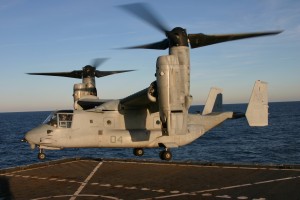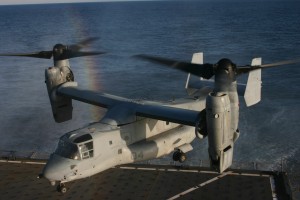An important development in the Libyan operation was the use of the MV-22 as the Fed Ex supply link between Naval Air Station Sigonella in Italy and the USS Kersarge.
In our interview with Lt. Col. Boniface, the new role for the MV-22 was underscored.

SLD: The Osprey is significant in logistics support for the fleet as well which was demonstrated during recent operations off of Libya.
Lt. Col. Boniface: I need to be very clear, the Osprey is not only supporting the USMC, but also supporting the USN-USMC team. During this deployment the USS Kearsarge suffered a mechanical loss of a propulsion screw. We were only able to do four knots through the water; at that point we were 300 miles from land. The only thing we could do was to get tech reps and parts out to the ship to allow us to make a best speed of 11 knots to get back into the fight. Remember you can’t really launch aircraft if you can’t make the correct wind across a flight deck, and you can’t effectively launch Harriers to continue their strike mission with four knots of wind either.
The Osprey was the only bird we could use to close this gap, fix the ship and continue the mission we were executing off the coast of Libya.
The V22 is like driving a Cadillac Escalade compared to your dad’s old truck. I’m traveling better; I’m able to carry more It’s more reliable, and efficient. It’s smoother. It’s safer.
Really comparing the CH-46E to the Osprey is like comparing apples and oranges. With the CH-46E, I am typically flying 300 feet at 110 knots. With the Osprey, I can be at 13,000 feet and flying at 250 knots, all with Marines and equipment in the back. I am flying an airplane, not a helicopter.
SLD: When we were talking earlier, you emphasized that the Osprey’s capabilities compared to the FROG was gamechanging in character. Could you elaborate?
Lt. Col. Boniface: It completely changes the game for the ARG/MEU, it changes the game for how the Marine Corps does business. I didn’t fully realize, nor appreciate this until I was operating in some of these locations during our deployment.
Once we got into the Med for the Libyan operations during Operation ODESSEY DAWN, Naval Air Station Sigonella was our only forward support base.
The Osprey functioned as a force multiplier in these circumstances. I could fly 300 miles plus from the USS Kearsarge to Naval Air Station Sigonella, land, get a quick hit of gas if needed, put five, six, seven thousand pounds of gear, equipment, troops, parts, and be back quickly to the ship within 2.5 hours.
Half of our MV-22s were conducting combat operations in Afghanistan while we were conducting combat operations off the coast of Libya aboard the USS Kearsarge. So you can do the math: Half of the Osprey’s conducting combat operation in Afghanistan and the other half performing combat resupply, and TRAP operations off the coast of Libya.
I wouldn’t have even fathomed this expeditionary and amphibious capability 10 years ago. Also, the Ospreys from Afghanistan flew directly to Souda Bay, Crete and then onto Naval Air Station Sigonella, Italy. This trip is a 3500 NM transit. This has been the longest in our short history, and they did it in one day. You can’t even begin to argue or compare and contrast these facts with the CH-46E.
https://sldinfo.com/the-role-of-the-osprey-in-operation-odyssey-dawn/

In Bold Alligator 2012, this role continued and expanded. Now the T-AKE supply ships have been certified for VM-22 landings. This means that the ability of this new aviation asset to connect the supply ships with the combat ships can potentially allow a much more efficient use of those combat ships. Supplies can be re-configured off of the combat ships to the supply ships and with the VM-22 have just in time delivery capabilities.
What this in turn means is that by building more of these new supply ships, the combat power of the fleet can be enhanced, and the USN-USMC team get its ship numbers up. This is not a substitute for adding new Amphibious ships to the fleet, it is not. But with the new approach and new con-ops the combat capabilities can become extended and more sustained. It is about sustainable maneuver warfare from the sea. And the new VM-22 T-AKE combination is a potential war winner.

